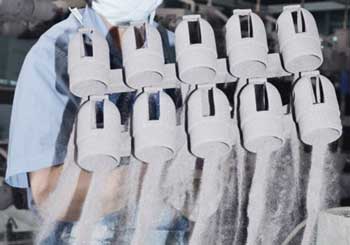Lost Wax Casting is a process in which an artist's sculpture is utilized to cast bronze. The Lost Wax Casting method is also known as Financial investment Casting in the modern industries. This is a very ancient approach used for casting little bronze sculptures, however today it is utilized to make many different artifacts as well as the process differs from factory to foundry. Today this established technique of Lost Wax Casting is used to make short articles like great jewelry, reveal pieces, dental restoration, a few specific commercial components as well as likewise some machine devices.
Process of Lost Wax Casting:
Rough Sculptor Making: An innovative musician makes an initial carver or mold or an artwork by using resources like wax, plaster or clay. A combination of oil based clay and also wax are favored as these products keep their softness.

Final Mold Making: A mold is then made based on the original sculptor. The mold is made up to 2 items and also a vital with shim is positioned in between the two items during construction so the mold and mildew can be placed accurately back with each other. Molds are normally used plaster or fiberglass or any other product that may be suitable. An internal mold and mildew of latex or plastic or silicone is put the pup preserve the information of the original artwork. Generally, the initial artwork constructed from plaster mold fractures as well as breaks during the first stage of deconstruction. Sometimes, numerable mold and mildews are required to get the precise reproduction of the initial artwork.
Filling out the mold: Once the latex as well as plaster mold and mildew is total and also ended up, molten wax is poured into the mold till it obtains an also finish around the mold and mildew. The thickness of the wax covering is around 1/8 inch. This procedure is then repeated until the preferred thickness is accomplished.
Removal of Wax Replica: The hollow wax replica of the initial artwork is then eliminated from the mold. The initial mold and mildew can be made use of for making more wax replicas, but because of the deterioration of the original mold the reuse of the mold is restricted.

Softening: Each wax mold and mildew is then chased or softened utilizing heated metal devices. The metal devices are rubbed around sections that show splits or the signing up with a line of the mold and mildew, where the items have actually come together. Independently shaped wax items are then heated up as well as affixed. The completed mold and mildew is after that worn order to conceal any type of flaws. The final piece after that appears like a bronze sculpture.
Making Paths For Molten Bronze: It is likewise called "spuring", in short the wax duplicate is after that branched with treelike wax, to ensure that the liquified bronze gets to the best components and likewise it aids the air to get away. The Lost wax Casting China crucial as well as careful spuring begins from the top of the wax duplicate. The top of the duplicate is affixed to by wax cyndrical tubes to various factors on the wax duplicate.
Slurry, fatigue, testing, putting, launch, metal-chasing, as well as painting are the last steps in the procedure of lost wax casting.
OTTOMMO Casting is a China Casting metal foundry with investment casting, die casting, sand casting and full in house CNC machining capabilities.
For further information please follow us : OTTOMMO CASTING